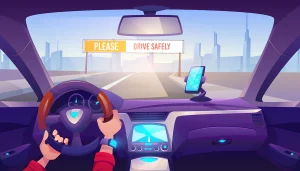The Dangers of Driving Distracted
Technology was meant to ease our life. Ironically that’s not always true. Let’s forget about dynamite and the war industry, and think about something much simpler we use daily. Exactly- I am talking about your cellphone. In terms of your time spent, it’s probably closer to you than your closest human companion. Thousands of articles, stories, or documentaries will tell you about this incredible technology’s side effects that make life so easy and communicable and the globe as small as a five-inch screen. You could talk about time wasting, radiation, and so on, but I am not telling you anything you already guessed.
Cause Of Distracted Driving
Mobile phones are responsible for a big chunk of people’s death in traffic accidents (termed as crashes in the United States). In summary, approximately three thousand people are losing life in traffic crash on US roads where at least one of the drivers were using their cellphones. As a driver, you are supposed to focus on your road- physically, visually, and mentally. The cell phone is one single thing that could take all of them away. You could take both hands off the steering to text or browse; meanwhile, your eye is already off the road; and your emotional focus on the cellphone already got your cognitive focus off the roadway surrounding. This manual, visual or cognitive drift from your focus in driving is often termed ‘distracted driving’ in academia. You would probably find thousands of research on this topic in top-ranked journals.
Behavioral Analysis Of Distracted Driving
Researchers went through many approaches to look into this issue. On a national level, surveys were done on people to hear their feeling about this. Surprisingly people believe this is dangerous but are often found to involve in this dangerous habit themselves. Other researchers also tried to evaluate it by using simulators to create virtual environments on a lab setup. They made people intentionally distracted to dive deeper and look at what triggered this behavior more. Finally comes the people who sneaked on drivers by mounting roadside cameras. Roadside cameras were very useful in looking into the features people chose to get distracted. However, those cameras look into a particular cross-section of the road, and hence you can’t tell which of the geometric properties of the road triggers this behavior. Few researchers installed cameras on their vehicles and started moving across high-speed roads, making their data collection unbiased and diverse. This approach facilitates the investigation of distracted driving behavior change for the variation of temporal and geometric roadway features.
Some key findings from distracted driving
Young drivers are most distracted than older drivers.
Improved roadway features increase distraction (wider median, wider shoulder, positive median)
Another avenue of DD research is the detection of drivers’ behavior. In-vehicle dash cameras do the best for this job. Companies like State Farm and the American University of Cairo have created a unique database to detect DD. Interestingly, this was a huge business, as these detection models, they further used to detect some other things like seatbelt compliance, drowsy driving, etc.
Solving The Distracted Driving Issues
In a nutshell, the research on DD is a hotcake nowadays. It’s a promising research area, and lots of work needs to be done by academia and industry to mitigate it. 3 E’s (Education, Engineering, and Enforcement) have been used. Engineering & Technology helped quite a bit. Insurance companies will give you a discount on their premium if you don’t get distracted. Advanced Vehicle Features would get you free by hands-free in vehicle technology. Education is also helping teach people (especially youth) about the dangers of distraction. Finally, high fiscal punishments by enforcement agencies have helped to reduce distractions. Combining all three 3Es is essential to solving this problem comprehensively. Coordination of practitioners, researchers, and policymakers can further lead to mitigating this dangerous behavior.

